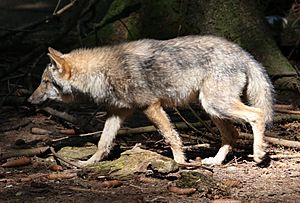Local extinction facts for kids
Local extinction, also called extirpation, happens when a species or other group of living things disappears from a specific area. This is different from global extinction, where a species vanishes from the entire world. With local extinction, the species still exists somewhere else, just not in that particular place.
Sometimes, when a species goes locally extinct, it can greatly change how the ecosystem works. This often happens if that species played a big role in the food web or helped keep the balance of life in that area. When it disappears, other species might also struggle or the amount of biomass (living matter) might shift.
Contents
What is Local Extinction?
Local extinction means a plant or animal group is no longer found in a certain region, even if it lives elsewhere. Imagine a type of bird that used to live in your local park but now only lives in other countries. That bird would be locally extinct from your park.
This is different from a species becoming extinct everywhere on Earth. For example, dinosaurs are globally extinct because none are left anywhere. But if a specific type of fish disappears from one lake, but still lives in other lakes, that's local extinction.
Why Does Local Extinction Matter?
When a species disappears from an area, it can have a big impact on the environment. Every species plays a part in its ecosystem. For instance, some animals help spread seeds, while others might control insect populations.
If a key species vanishes, it can upset the natural balance. For example:
- A predator disappearing might lead to too many prey animals.
- A plant that provides food for many animals might be lost.
- The overall health of the habitat can suffer.
This can sometimes cause a chain reaction, where other species also struggle or disappear from that area.
Bringing Species Back: Reintroduction
Sometimes, people try to bring species back to areas where they went locally extinct. This is called reintroduction. It's like moving a species from a place where it still lives to a place where it used to live.
Reintroduction can be tricky. If a species has been gone for a long time, the ecosystem might have changed a lot. It can take a lot of planning and effort to make sure the reintroduced animals or plants can survive and thrive.
Grey Wolves in Yellowstone
A famous example of reintroduction is the grey wolf in Yellowstone National Park in the United States. Wolves were hunted and disappeared from Yellowstone by the 1920s. This was a local extinction for the park.
Without wolves, the number of elk (a type of deer) grew very large. The elk ate too many young trees and plants, which changed the landscape and affected other animals.
In the mid-1990s, grey wolves were brought back to Yellowstone. This reintroduction helped to:
- Control the elk population.
- Allow trees and plants to grow back.
- Bring back other animals like beavers, which depend on those trees.
The return of the wolves showed how important one species can be to an entire ecosystem.
Images for kids
See also
 In Spanish: Extinción local para niños
In Spanish: Extinción local para niños



